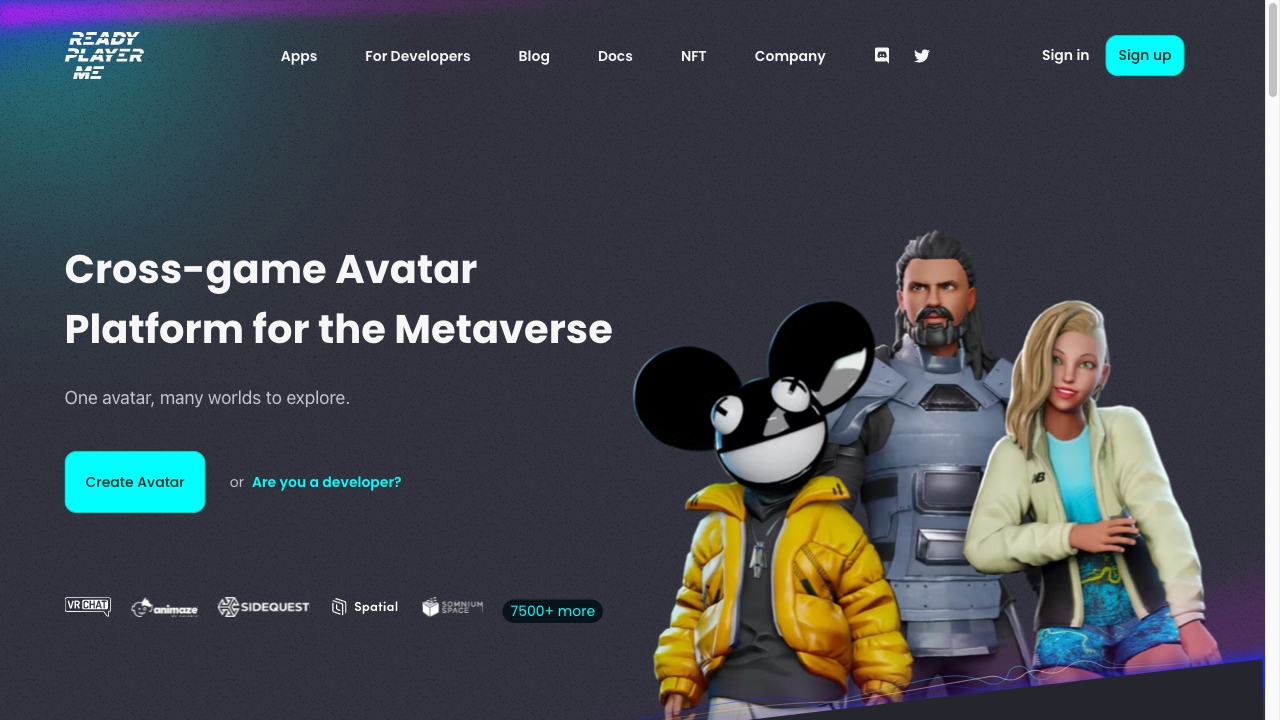- Home
- AI Avatar Generator
- Ready Player Me

Ready Player Me
Open Website-
Tool Introduction:AI grammar checker for 30+ languages with rewrite and style fixes
-
Inclusion Date:Oct 21, 2025
-
Social Media & Email:
Tool Information
What is Ready Player Me AI
Ready Player Me AI is a cross-game avatar platform built for the metaverse. It lets players create a single, high-quality 3D avatar—often from a simple selfie—and carry it across many virtual worlds, games, and social experiences. For developers, it offers SDKs, APIs, and hosting to integrate interoperable, personalized avatars quickly, cutting development time while boosting user retention and engagement. The platform supports both live titles and games in development, including options to enable avatar customization economies and new revenue streams.
Ready Player Me AI Main Features
- Cross-game interoperability: One persistent player identity that travels across multiple games and virtual worlds.
- Developer-friendly SDKs: Integration for Unity, Unreal Engine, and web, with straightforward APIs and sample projects.
- Selfie-to-avatar creation: Convert a photo into a personalized 3D avatar and refine it with extensive customization.
- Animation-ready rigs: Standardized skeletons and blendshapes compatible with common animation workflows.
- Performance and scalability: Optimized assets and hosted delivery to support mobile, PC, VR, and AR experiences.
- Embeddable creator UI: Drop-in avatar creator flows to reduce UI/UX work and speed up onboarding.
- Avatar API and syncing: Store, update, and fetch avatars across titles to keep player identity consistent.
- Monetization tooling: Support for cosmetic items and avatar economies to drive incremental revenue.
Who Should Use Ready Player Me AI
Ready Player Me AI suits indie and AAA game studios, metaverse platforms, social and UGC apps, and teams building VR/AR experiences. It also fits virtual events, online communities, and training or education products that need fast, consistent avatar systems across multiple titles or modules.
How to Use Ready Player Me AI
- Create a developer account and review the documentation and samples.
- Select your stack (Unity, Unreal, or Web) and install the appropriate SDK or package.
- Configure project settings and platform targets (mobile, desktop, VR/AR).
- Embed the avatar creator flow; enable selfie import or manual customization as needed.
- Retrieve the avatar ID or URL via the API and load the avatar at runtime; cache when appropriate.
- Bind the avatar to the player profile to persist identity across sessions and titles.
- Integrate animations/IK and test performance on target devices and networks.
- Enable monetization for cosmetics if desired, then QA, launch, and monitor engagement.
Industry Use Cases for Ready Player Me AI
A VR social app lets users import a single avatar at sign-in, raising session length and friend connection rates. A mobile racing game uses avatars as driver identities, selling outfits and helmets as cosmetic IAPs. An enterprise training suite shares the same avatar across modules, reducing art and engineering time. A virtual concert platform offers pre-show avatar customization with branded wearables to drive sponsorship revenue.
Ready Player Me AI Pricing
Developers can typically start for free with SDKs and documentation. Production use and monetization features may require commercial terms. Revenue-sharing models for avatar items can be supported in live games. Enterprise support and custom agreements are available; teams should contact the vendor for current licensing and trial details.
Ready Player Me AI Pros and Cons
Pros:
- One interoperable avatar across many worlds improves user retention.
- Faster time to market versus building a full avatar system from scratch.
- High-quality, animation-ready characters with deep personalization.
- Cross-platform performance for mobile, PC, VR, and AR.
- Embeddable creator UI and straightforward developer tools.
- Built-in pathways for cosmetic monetization and new revenue streams.
Cons:
- Dependency on a third-party service and its product roadmap.
- Fewer ultra-specific art pipeline controls than bespoke solutions.
- Network connectivity needed for creation, updates, and syncing.
- Commercial licensing or revenue share may apply for production monetization.
- Stylized projects may require extra tuning to match unique art directions.
Ready Player Me AI FAQs
Question 1: Does it support Unity and Unreal Engine?
Yes. Ready Player Me AI provides SDKs and samples for Unity and Unreal, plus web integration options.
Question 2: Can players use the same avatar across multiple games?
Yes. The platform is designed for cross-game identity, letting users carry one avatar into many compatible titles.
Question 3: How are avatars created?
Players can generate an avatar from a selfie or build one manually, then customize details like face, hair, and outfits.
Question 4: Is it optimized for mobile and VR?
Avatars and delivery are performance-conscious to support mobile, PC, VR, and AR, with optimizations recommended per platform.
Question 5: Can developers monetize avatar items?
Yes. The platform supports cosmetic economies, enabling in-game purchases of avatar assets subject to applicable commercial terms.
Question 6: How is user data handled?
Developers should configure authentication and follow applicable privacy and security best practices; consult the vendor for compliance details.
